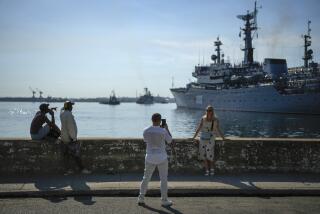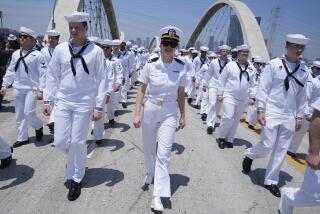Sevastopol Rolls Out Red Carpet for U.S. Sailors
- Share via
SEVASTOPOL, Soviet Union — Famed for its tenacity in two historic sieges, this Soviet port succumbed instantly Friday to the smiles and enthusiasm of 600 American sailors who arrived on the first U.S. warships ever to call here.
“If it had been like this all the time, it would have been magnificent,” said retired blacksmith Yuri D. Vlasov who, with his daughter and granddaughter, was among thousands of Soviet citizens who waved, whistled and threw gifts to crewmen as the cruiser Thomas S. Gates and the frigate Kauffman were warped into their berths.
“This is the first time I’ve seen real live Americans,” said Sergei Basalayev, a vacationer from western Siberia who caught one of the white hats the Americans tossed into the excited crowd. “They’re just like us, except maybe a little less inhibited.”
Part of Official Program
The American ships arrived Friday on a five-day visit as part of an official Soviet-American military contacts program that began last year. Three Soviet warships called at Norfolk, Va., last month as part of the same program.
“I hope that this is not the last visit,” Soviet Vice Adm. Vitaly P. Larionov told his American counterpart, Vice Adm. R. Paul Ilg, as he boarded the Gates for the official welcome. “I hope our relations will improve with each day, and the commanders of our ships will lay their courses to each other’s harbors in the name of good will.”
The Gates and a shore battery exchanged 21-gun salutes as the ships steamed into the busy harbor, headquarters of the Soviet Black Sea Fleet, under the escort of two Soviet guided missile vessels.
At first, the Americans lined the rails of their ships in silence, under orders to remain at attention while Soviet personnel on nearby ships and the civilian crowds waved and cheered. Finally, as the Gates was tying up, the order came to stand down.
“Hey guys!” one of the Americans shouted, “the word from the bridge is, if you’re not busy, wave your hats.”
One American, followed by dozens of others, flung his hat into the appreciative crowd.
“Davai! Davai!” the Russians shouted. “Come on! Come on!”
A Soviet teen-ager leaped from the pier into the murky water to retrieve several hats that had fallen short of the mark.
In return, the Soviets showered the ships with coins, souvenir lapel pins, cigarettes, candy and flowers. Women shouted at the Americans to buy ice cream with the money.
As they disembarked for a few hours of liberty, the Americans were mobbed. They posed for photographs, signed autographs and traded souvenirs of a visit both sides are likely to remember for a long time.
“I’ve never had so many people pay so much attention to me before,” said Steve Danskine of Roseburg, Ore.
As the Americans set out in twos and threes to explore the city, they found scores of willing young Soviet escorts, apparently eager to meet them and perhaps share the limelight.
This was the first U.S. naval visit to any Soviet port since May, 1975, during a period of Soviet-American detente. That visit was to Leningrad, long an open city for foreign travelers.
Historically, Sevastopol has been closed to foreigners, and since 1984, even Soviet citizens have needed special permission to visit here.
Vice Adm. Ilg told a news conference that his ships had been propelled “by winds of change that are blowing through your country.”
Adm. Mikhail N. Khronopulo, commander of the Black Sea Fleet, agreed, saying that “it would have been hard to imagine this kind of situation even two years ago.”
Sevastopol, a pleasant city of about 400,000 people, is a natural harbor surrounded by hills. In the Crimean War of 1854-56 with England, France and Turkey, it fell after a siege of nearly a year. In World War II, it was captured by German troops after a siege of eight months.
The American sailors said they had been given almost no special security instructions, and what instructions they were given appeared to bear this out. More space was devoted to warning them of the potential pitfalls of dealing with the media than in contacting Soviet citizens.
They were warned against black-market dealings and reminded that, even more than in other circumstances, they were representing the good name of the United States.
Capt. Robert Sutton, the Gates’ commanding officer, reportedly told his men that “one of the worst things about American culture is ‘boom boxes’ (large portable radios),” and he ordered the men not to use them either on board ship or ashore.
The U.S. warships are to be open to public tours for three hours a day starting today. Crewmen are to serve hot dogs and soft drinks to the thousands of Soviet guests expected.
Some areas of the ships, including their command and control centers, would be off limits, according to U.S. officers. Ilg said in reply to a reporter’s question that the ships would adhere to standing U.S. policy of neither confirming nor denying the presence or absence of nuclear weapons.
Much of the Americans’ time ashore will be devoted to taking part, in organized groups, in activities planned by their Soviet hosts. These were to include visits to a local winery, a state farm, museum concerts and a youth camp.
The Americans were loaded down with souvenirs to give to the Soviet people they meet, but within hours many had exhausted their supplies.
“I want to find a Russian sailor and trade him for his hat,” said Charles Johnston, a communications specialist from Marietta, Ga.
The Sevastopol visit has special meaning for Command Master Chief Bobby Scott, the highest-ranking enlisted man on the Gates. Scott, a native of Memphis, will celebrate 37 years in the Navy today, and he intends to re-enlist for a final three years while here.
“To be able to do it in the Soviet Union is something to talk about,” Scott said. “I’ve got seven grandchildren, and I want to see Russia, so I can tell them about it.”
More to Read
Sign up for Essential California
The most important California stories and recommendations in your inbox every morning.
You may occasionally receive promotional content from the Los Angeles Times.













